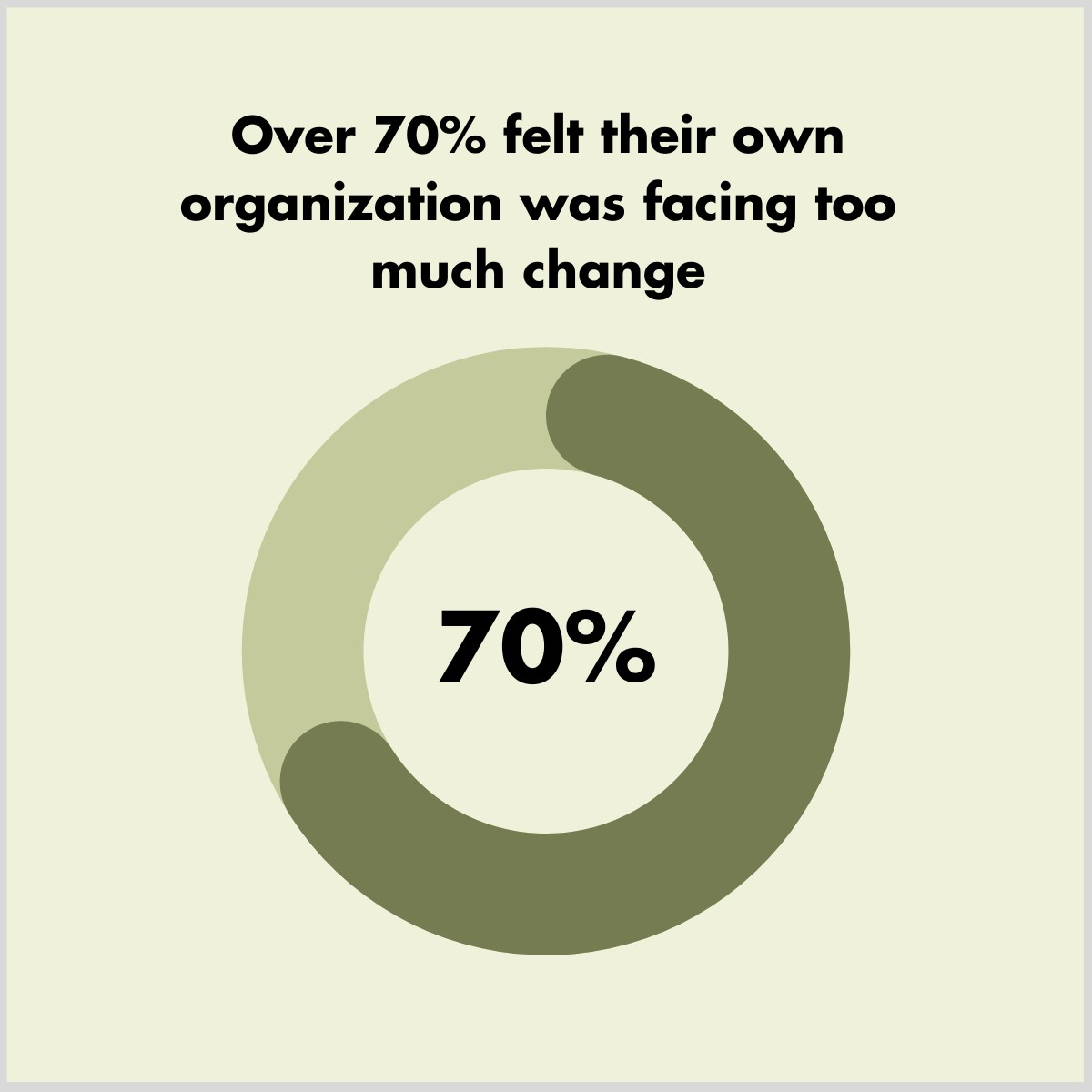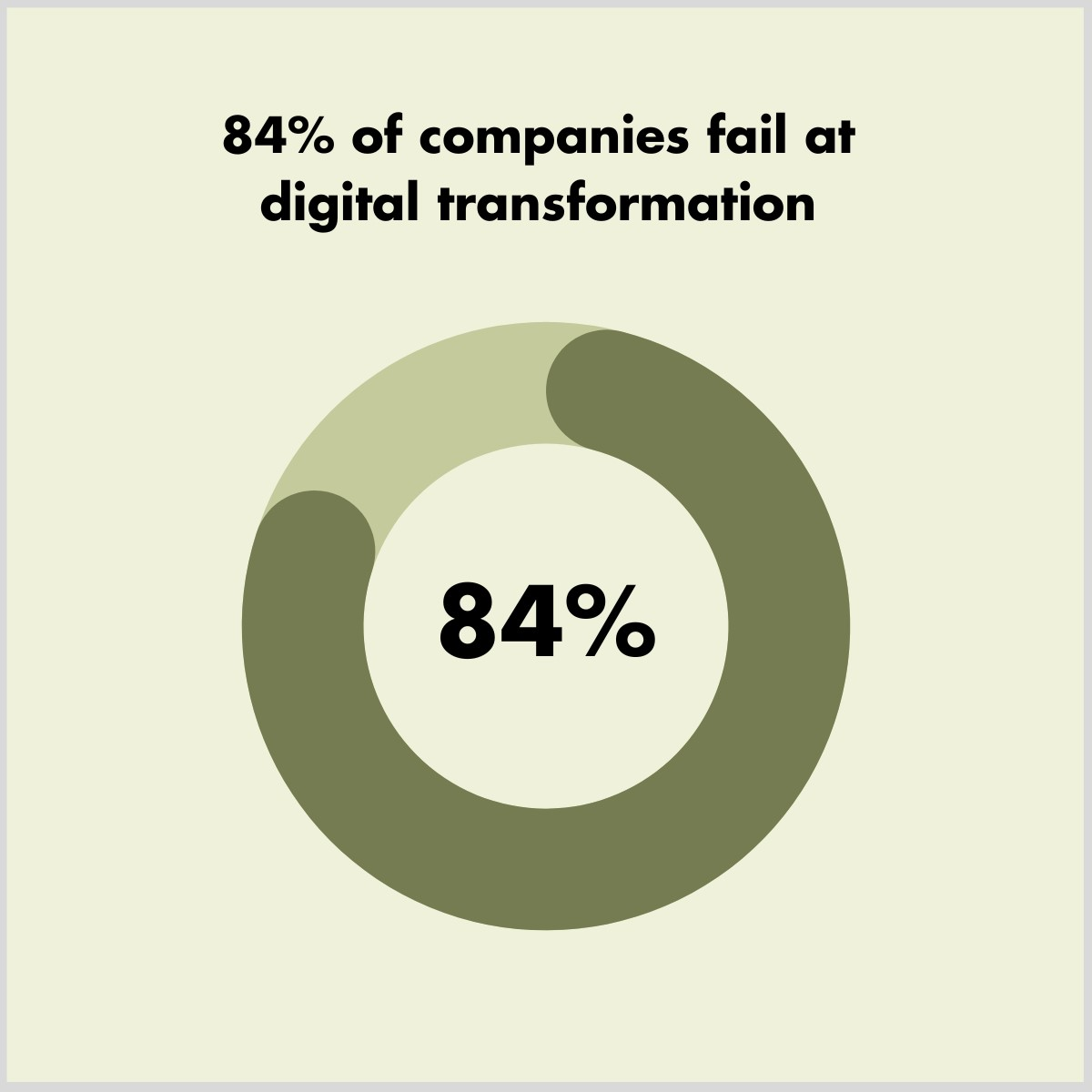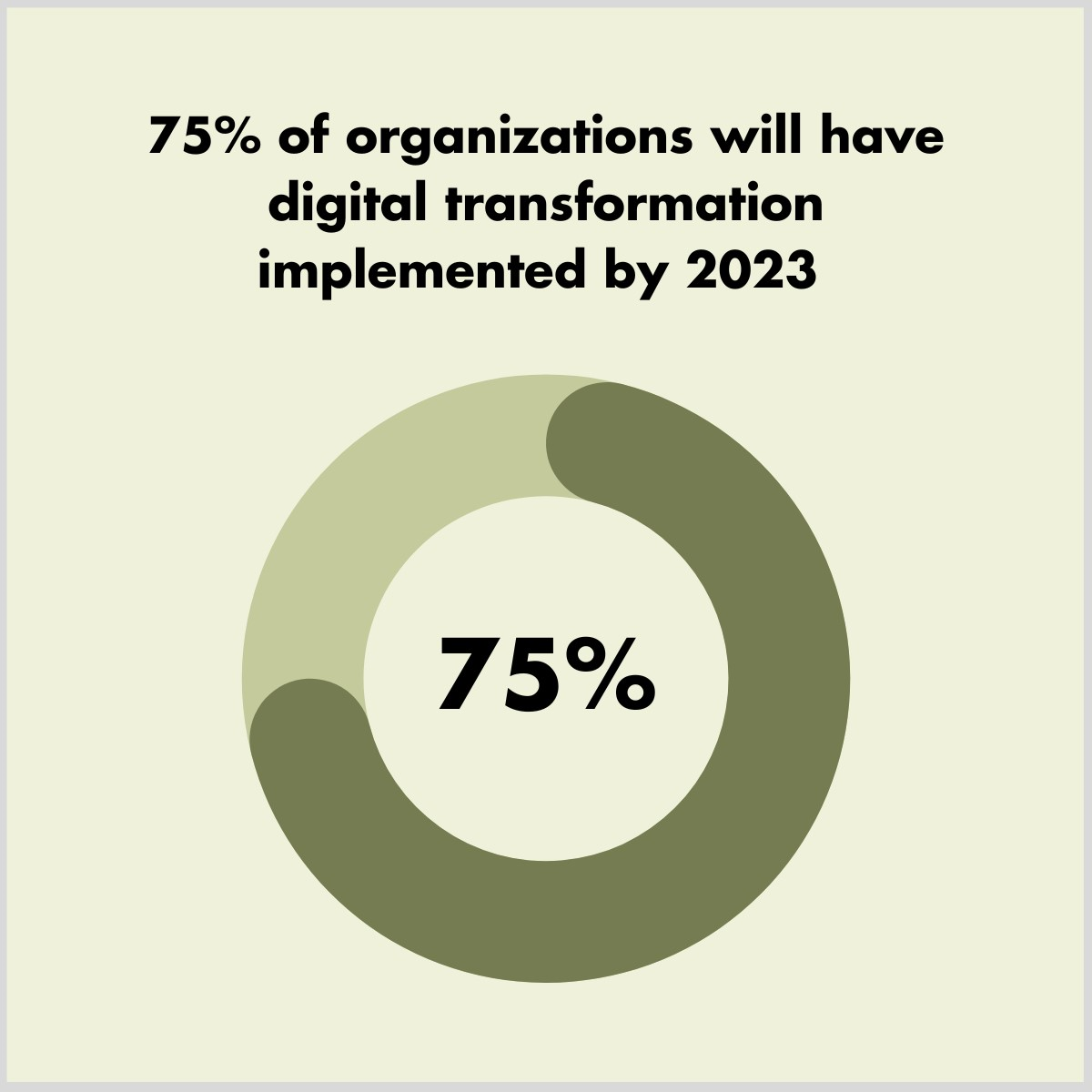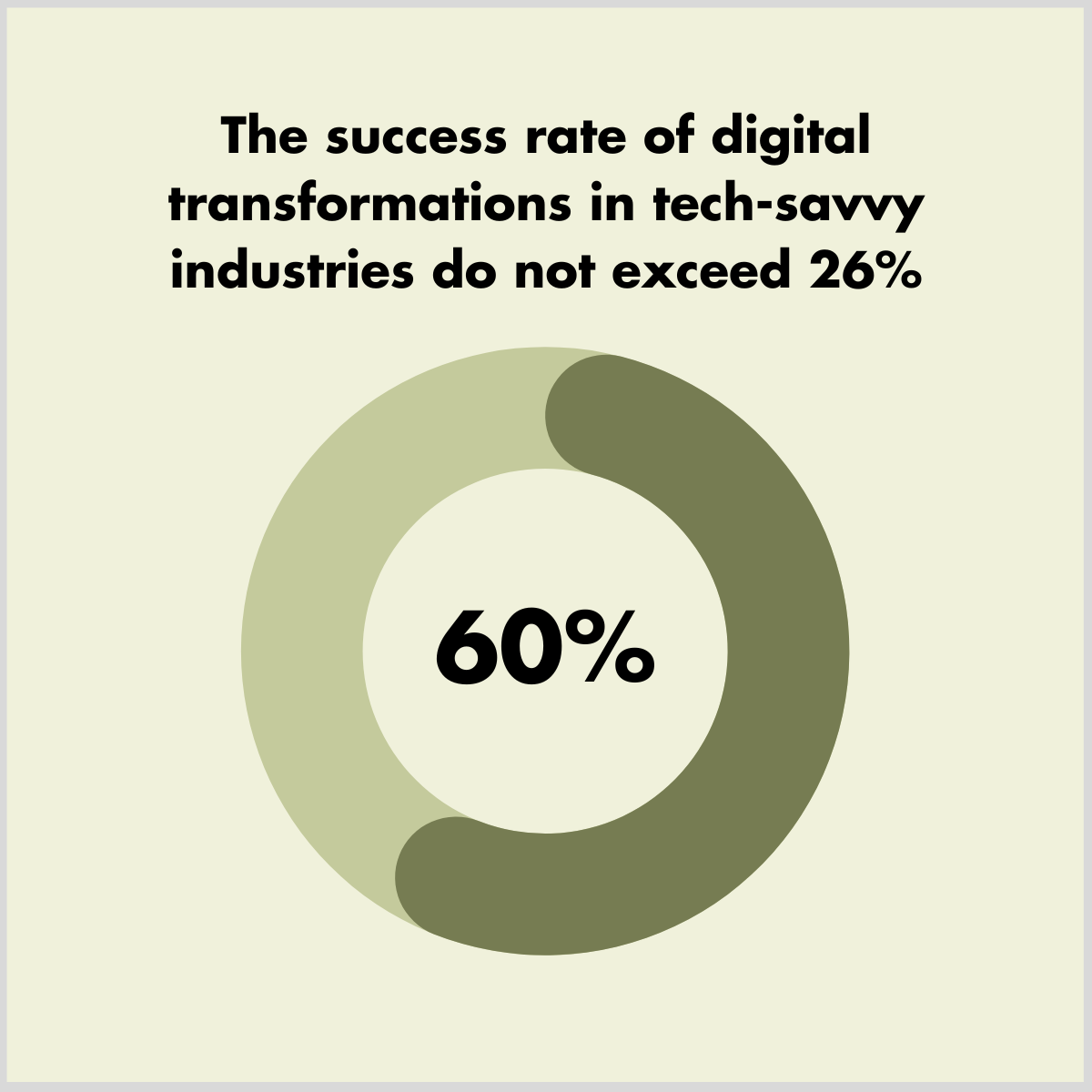Understanding the pulse of change management is more crucial than ever.
To shed light on the dynamic realm of change management, we delve into a comprehensive overview of change management statistics. These statistics unveil trends, insights, and the power of technology toward successful change adoption.
Through this lens, we’ll delve into the current state of change management, highlighting the significant numbers that every change manager should be aware of.
Top Change Management Statistics
Before you dive into the full report, take a moment to go over some of the top change management statistics and current trends:
-
In a survey of 1,284 executives, 85% of senior executives noted an explosive increase in organizational change projects over the past five years.
-
The failure of 72 percent of transformations can be attributed to inadequate management support for the change (33 percent) and employee resistance (39 percent).
-
The success rate of digital transformations in tech-savvy industries do not exceed 26%. In traditional industries, the success rate is bleaker at only between 4-11%.
-
When effectively executed, 6 key drivers (care, lead, build, empower, inspire, collaborate) can enhance the chances of achieving a successful outcome by 2.6 times, raising the likelihood to 73%.
-
In 2022, a substantial 64% of organizations are making significant to moderate investments in learning and development, a significant increase from the 29% reported in 2020.
-
Demand for change management professionals, classified as management analysts, has increased by 10% – much faster than the average rate
The State of Change Management Statistics
Change management practices can differ significantly among organizations. Some have well-defined best practices, while others manage changes on the go, often without a designated “change manager.” These statistics offer a panoramic overview of the current state of this dynamic field’s practices.
85% of senior executives noted an explosive increase in organizational change projects over the past five years (Harvard Business Review)

86% of Change Enablers always or usually use standardized project and project management initiatives to implement organizational change (PMI’s 2014 Pulse of the Profession Report)
For the past years, there has been a substantial surge in organizational change projects, indicating a growing need for effective change management strategies and practices to successfully navigate and adapt to these rapid changes in the business environment.
The integration of change and project management signifies the acknowledgment of the synergy between these disciplines, leading to improved project success rates and a more holistic approach to implementation.
Over 70% of people responding to the Change Demand Assessment felt their own organization was facing too much change (Change First)

A significant majority feel overwhelmed, believing that their organization lacks the necessary focus and resources to execute vital projects sustainably. This underlines the need for organizations to prioritize and manage change initiatives more effectively, ensuring that employees are not overwhelmed and that business-critical projects do not suffer.
76% (3 out of 4 employees) feel burned out at work at least sometimes (2020 Gallup Perspective on Employee Burnout: Causes and Cures)
This statistic emphasizes the acute levels of workplace stress and burnout currently being experienced by a significant majority of employees. High burnout rates can hamper the ability of individuals to effectively receive, process, and act on changes being communicated within an organization.
This underlines the importance of tailoring change communication strategies, especially when addressing a workforce already facing high levels of fatigue and stress. It also stresses the need for leaders to be more empathetic and understanding of employees affected, while driving organizational changes.
6 key drivers (care, lead, build, empower, inspire, collaborate) can enhance the chances of achieving a successful outcome by 2.6 times, raising the likelihood to 73%. (EY and the University of Oxford)

The EY and the University of Oxford report sheds light on the importance of human-based approach to successful change initiatives within organizations. Despite the high risk of failure, focusing on and effectively implementing these six key drivers can significantly improve the chances of success in managing change initiatives.
85% of organisations reported an unsuccessful change initiative in the last two years (Human Capital Institute)
This statistic indicates that a vast majority of organizations are facing challenges in implementing successful, change programs. This underscores the complexity and difficulty associated with managing organizational change. With such a high failure rate, there’s a clear and urgent need for better strategies and methodologies in change management.
84% of companies fail at digital transformation (Forbes)

According to Forbes 84% of digital transformation efforts do not reach their goals, often due to lack of awareness of its challenges and lack of understanding of its drivers. As per McKinsey, BCG, KPMG, and Bain & Company, the likelihood of unsuccessful outcomes ranges from 70% to 95%. These challenges span various factors, and insufficient change management efforts emerge as a significant contributor to the staggering failure rates observed in digital transformation initiatives.
The failure of 72 percent of transformations can be attributed to inadequate management support for the change (33 percent) and employee resistance (39 percent) (McKinsey & Company The State of Organizations 2023)
Dealing with employee resistance is a prevailing challenge in the realm of change management. This statistic sheds light on the pervasive nature of resistance and highlights the importance of robust strategies to mitigate its effects..
60% of executives and project managers identified altering mindsets and attitudes as the primary hurdle in implementing change within an organization, with corporate culture trailing closely behind at 49% (IBM Global Study)

Addressing and effectively managing mindset and attitude changes among key stakeholders, along with nurturing a supportive corporate culture, are critical factors for success when implementing change within an organization.
About 65% of employees believe that their companies providing training and development opportunities are essential for their job satisfaction (LinkedIn Workplace Learning Report)
The statistics from the LinkedIn Workplace Learning Report paint a compelling picture of the connection between employee training and job satisfaction. This finding resonates with the growing recognition that investing in employees’ growth journey contributes not only to their personal development but also to the organization’s success.
80% of senior executives believe that change leadership will be even more vital in the next five years compared to the past (PwC CEO Insights Survey)
The significance of leading change is projected to grow. This statistic serves as a resounding affirmation of the forward-looking mindset that leaders embrace as they chart their courses in the evolving business landscape.
Change Management in the Digital Era Statistics
Change management is interwoven with the transformative forces of technology. A collection of statistics reveals a story that highlights how technology and effective change management practices are intertwined in a mutually beneficial relationship.
Spending is projected to soar to $2.3 trillion in 2023, constituting over half of all IT expenditures (IDC Worldwide Digital Transformation Spending Guide)
The saga begins with the formidable investments that digital transformation commands. Globally, spending is projected to soar to $2.3 trillion in 2023, constituting over half of all IT expenditures. This resounding figure attests to the strategic significance many organizations attach to digital metamorphosis.
75% of organizations will have comprehensive digital transformation implemented by 2023 (IDCWorldwide Digital Transformation 2021 Predictions)

The prevalence of digital transformation underscores the need for consistent communication and effective change management, as organizations navigate the complexities of adapting to technological advancements.
The global market for public cloud services is predicted to experience a 17% growth in 2020, reaching a total of $266.4 billion, a significant increase from the $227.8 billion recorded in 2019 (Gartner)
The substantial growth in the global market for public cloud services has notable implications for change management. Organizations are likely to increasingly adopt cloud-based solutions to enhance their operations, and this shift can necessitate significant changes in workflows, processes, and even organizational culture. Change management strategies will be crucial to effectively navigate and integrate these technological advancements
Global revenue generated by enterprise applications is anticipated to increase from $279.6 billion in 2022 to $385.2 billion in 2026, showing a compound annual growth rate (CAGR) of 8.0% over the five-year period (International Data Center)
The trajectory of enterprise software mirrors resilience. The majority of this growth will be driven by investments in public cloud software, which is predicted to account for nearly two-thirds of total revenue from enterprise applications in 2026.
Change management will play a crucial role in facilitating this transition, ensuring that organizations effectively integrate new enterprise applications into their operations, and that employees can adapt to and maximize the benefits of these technologies.
Worldwide spending on information security and risk management technology is poised to exceed $150 billion in 2021 (Gartner)
The significant investment in information security and risk management technology highlights the importance of change management in ensuring a smooth transition. Change managers should prioritize security awareness, compliance, and employee training to mitigate risks and maximize the benefits of these technologies.
Global earnings in the collaboration applications sector increased by 28.4% compared to the previous year, reaching a total of $29.1 billion in 2021 (International Data Center)
This data shows us that collaboration emerges as a steadfast protagonist in this technological odyssey. The rapid expansion of collaboration applications indicates that organizations are increasingly relying on digital tools for communication and collaboration. Change managers need to consider the impact of these technologies on workplace dynamics and employee workflows.
Only 5% of respondents say their organizations already have the right capabilities in place to support technological or digital components in their strategies. (McKinsey The State of the Organizations Survey 2023)

The McKinsey 2023 State of the Organizations Survey reflects a significant deficiency in the state of change management within these entities. It underscores a prevalent skill gap, with the vast majority of organizations ill-prepared to navigate digital transformations effectively.
The success rate of digital transformations in tech-savvy industries do not exceed 26%. In traditional industries, the success rate is bleaker at only between 4-11% (McKinsey Report)

This number highlights the critical role of robust change management strategies in mitigating risks and ensuring the successful execution of digital transformation initiatives.
Learning and Development Statistics
Change management and learning & development (L&D) often intersect, as preparing individuals for change frequently requires equipping them with new knowledge, skills, and behaviors. Here are some statistics related to workplace change management in the context of learning and development.
Improving the employee work experience takes the top spot (78%) for the future of work / digital transformation (Brandon Hall)

The Brandon Hall Group research indicates a substantial rise in change management across various aspects of human capital management since 2020. This suggests that organizations are increasingly recognizing the need to effectively manage change processes and transitions within their workforce, making it a crucial aspect of modern HR and organizational strategy.
In 2022, a substantial 64% of organizations are making significant to moderate investments in learning and development, a significant increase from the 29% reported in 2020 (Brandon Hall)
The implication of this data is that organizations have recognized the growing importance of investing in learning and development as a means to enhance employee skills and knowledge, indicating a greater commitment to preparing employees for changes within the organization. This increased investment underscores the interconnection between learning and development initiatives and successful change management efforts.
33% of high-performing companies believe their employees have the capability for planning for change, compared to 13% of other companies.
32% of high-performing companies believe their employees have the capability for executing change, in contrast to 19% of other companies.
37% of high-performing companies think their employees have the capability for sustaining change, while only 17% of other companies believe the same
(The Human Capital Institute)
The data suggests a correlation between a company’s performance and the change management capabilities of its employees. High-performing companies have a higher proportion of employees skilled in change management aspects such as planning, executing, and sustaining change.
For organizations aiming to enhance their performance, investing in change management training and development could be pivotal. The notable gap between high-performing companies and others in recognizing these capabilities underscores the importance of fostering a culture and environment that empowers employees to adeptly navigate change. This can lead to better resilience, adaptability, and overall performance in a dynamic business landscape.
58% of employees prefer online learning tools with content broken into shorter lessons. (Software Advice)
A study by Software Advice showed that 58% of employees would be more likely to use their company’s online learning tools if the content was broken up into multiple, shorter lessons. This suggests that microlearning can be an effective strategy in change management.
Additionally, based on Deloitte’s 2017 Global Human Capital Trends, companies are now shifting from the traditional LMS to newer learning tools available in the market.
79% of talent developers expect to spend more of their budget on online learning. (LinkedIn’s 2021 Workplace Learning Report)
The same LinkedIn report indicated that 57% of talent developers plan to spend more on online learning. E-learning platforms provide flexibility, which is vital during change management, as it allows employees to learn at their own pace.
The half-life of a learned skill is now only 5 years (The 100-Year Life: Living and Working in an Age of Longevity)

A report by Deloitte mentioned that the half-life of a learned skill is now only 5 years, emphasizing the need for continuous learning and development as part of change management
94% of employees would stay at a company longer if it invested in their L&D (LinkedIn’s 2019 Workplace Learning Report)

According to LinkedIn’s 2020 Workplace Learning Report, 94% of employees would stay at a company longer if it invested in their learning and development. An organization with a strong learning culture can adapt to change more seamlessly.
Nearly 90% of managers believe that their superiors would say they are good coaches. Less than one third of HR managers agree with the managers’ self-assessment. (Betterworks Survey)
The disparity in perceptions indicates a potential lack of alignment or understanding regarding what effective coaching looks like in an organization. Focusing solely on problems and processes during coaching can lead to resistance and frustration, emphasizing the importance of a more conversational and empowering approach to coaching for change. For a change manager, understanding and adapting to this more effective approach can greatly enhance their impact and the success rate of their initiatives.
The Professional Landscape Statistics
The realm of change management professionals offers a compelling narrative of growth and reward. As we delve into the professional landscape, let’s explore the nuances that shape this dynamic field:
Demand for change management professionals, classified as management analysts, has increased by 10% – much faster than the average rate (U.S. Bureau of Labor Statistics)
Change management professionals, strategically categorized as management analysts, are experiencing an upward trajectory of demand. This surge, quantified at an impressive 10%, propels change management beyond the realms of ordinary occupations. This surge, backed by data from the U.S. Bureau of Labor Statistics (BLS), positions change management professionals at the forefront of sought-after expertise.
On average, there are expected to be approximately 92,900 job opportunities for management analysts annually over the next decade (U.S. Bureau of Labor Statistics)

The vast number of open roles for change management in the U.S. underscores the growing demand and importance of change management professionals in the country. This statistic demonstrates the pivotal role these specialists play in modern business operations and transformations.
A change manager with less than 1 year experience can expert to earn $60k while an experienced change manager later in their year (20 years and higher) earn an average total compensation of $127k (Payscale)
The canvas is an indicator of the value organizations attribute to the role of change management.
For change management professionals, extensive experience illuminates the path to rewards. Those who amass over 20 years of expertise carve a distinct trajectory, ascending to earn up to 25% more than their counterparts. This data reveals that experience is a premium in this field, highlighting the depth and complexity of the skills that change managers acquire over time.
Change managers rate their job satisfaction at 4 out of 5 or higher (Payscale)
Reviews from platforms like Glassdoor and Payscale frequently show change managers rating their job satisfaction at 4 out of 5 or higher. This high level of job satisfaction reflects the rewarding nature of the profession and its alignment with personal and professional growth.
Key Takeaways
The insights from these statistics underscore several vital areas for change managers.
Firstly, the efficacy of structured change management strategies is clear, as they drastically increase the likelihood of project success. Yet, there remains a prevalent issue of unsuccessful change initiatives, often rooted in employee resistance. This calls for an inclusive approach, emphasizing early employee engagement and continuous feedback.
Digital transformations, although popular, exhibit a high failure rate. Gaps in employee skills and understanding is critical. Thus, investing in comprehensive training and development is not just essential for successful digital shifts but also paramount for overall employee job satisfaction.
Looking ahead, with the growing demand for skilled change management professionals and an anticipated increase in the importance of change leadership, change managers and senior leaders must prioritize continuous upskilling and cultivate adaptable leadership traits to stay ahead of the curve.



